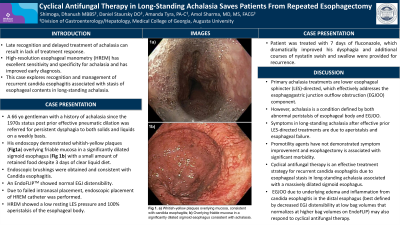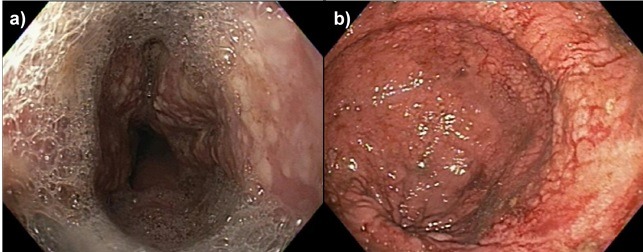Tuesday Poster Session
Category: Esophagus
P3282 - Cyclical Antifungal Therapy in Longstanding Achalasia Saves Patients From Repeated Interventions and Esophagectomy
Tuesday, October 24, 2023
10:30 AM - 4:00 PM PT
Location: Exhibit Hall

Has Audio
- DS
Dhanush Shimoga, MBBS
Medical College of Georgia at Augusta University
Augusta, GA
Presenting Author(s)
Dhanush Shimoga, MBBS1, Daniel Staursky, DO2, Amanda Tyra, PA-C1, Amol Sharma, MD, MS, FACG1
1Medical College of Georgia at Augusta University, Augusta, GA; 2Augusta University, Augusta, GA
Introduction: Late recognition and delayed treatment of achalasia can result in lack of treatment response. High-resolution esophageal manometry (HREM) has excellent sensitivity and specificity for achalasia and has improved early diagnosis. This case explores recognition and management of recurrent Candida esophagitis associated with stasis of esophageal contents in long-standing achalasia.
Case Description/Methods: A 66 yo gentleman with a history of achalasia since the 1970s status post prior effective pneumatic dilation was referred for persistent dysphagia to both solids and liquids on a weekly basis. His endoscopy demonstrated whitish-yellow plaques (Fig 1a) overlying friable mucosa in a significantly dilated sigmoid esophagus (Fig 1b) with a small amount of retained food despite 3 days of clear liquid diet. Endoscopic brushings were obtained and consistent with Candida esophagitis. An EndoFLIPTM showed normal EGJ distensibility. Due to failed intranasal placement, endoscopic placement of a HREM catheter was performed. HREM showed a low resting LES pressure and 100% aperistalsis of the esophageal body. Patient was treated with 7 days of fluconazole, which dramatically improved his dysphagia and additional courses of nystatin swish and swallow were provided for recurrence.
Discussion: Primary achalasia treatments are lower esophageal sphincter (LES)-directed, which effectively addresses the esophagogastric junction outflow obstruction (EGJOO) component. However, achalasia is a condition defined by both abnormal peristalsis of esophageal body and EGJOO. Symptoms in long-standing achalasia after effective prior LES-directed treatments are due to aperistalsis and esophageal failure. Promotility agents have not demonstrated symptom improvement and esophagectomy is associated with significant morbidity. Cyclical antifungal therapy is an effective treatment strategy for recurrent Candida esophagitis due to esophageal stasis in long-standing achalasia associated with a massively dilated sigmoid esophagus. EGJOO due to underlying edema and inflammation from Candida esophagitis in the distal esophagus (best defined by decreased EGJ distensibility at low bag volumes that normalizes at higher bag volumes on EndoFLIP) may also respond to cyclical antifungal therapy.

Disclosures:
Dhanush Shimoga, MBBS1, Daniel Staursky, DO2, Amanda Tyra, PA-C1, Amol Sharma, MD, MS, FACG1. P3282 - Cyclical Antifungal Therapy in Longstanding Achalasia Saves Patients From Repeated Interventions and Esophagectomy, ACG 2023 Annual Scientific Meeting Abstracts. Vancouver, BC, Canada: American College of Gastroenterology.
1Medical College of Georgia at Augusta University, Augusta, GA; 2Augusta University, Augusta, GA
Introduction: Late recognition and delayed treatment of achalasia can result in lack of treatment response. High-resolution esophageal manometry (HREM) has excellent sensitivity and specificity for achalasia and has improved early diagnosis. This case explores recognition and management of recurrent Candida esophagitis associated with stasis of esophageal contents in long-standing achalasia.
Case Description/Methods: A 66 yo gentleman with a history of achalasia since the 1970s status post prior effective pneumatic dilation was referred for persistent dysphagia to both solids and liquids on a weekly basis. His endoscopy demonstrated whitish-yellow plaques (Fig 1a) overlying friable mucosa in a significantly dilated sigmoid esophagus (Fig 1b) with a small amount of retained food despite 3 days of clear liquid diet. Endoscopic brushings were obtained and consistent with Candida esophagitis. An EndoFLIPTM showed normal EGJ distensibility. Due to failed intranasal placement, endoscopic placement of a HREM catheter was performed. HREM showed a low resting LES pressure and 100% aperistalsis of the esophageal body. Patient was treated with 7 days of fluconazole, which dramatically improved his dysphagia and additional courses of nystatin swish and swallow were provided for recurrence.
Discussion: Primary achalasia treatments are lower esophageal sphincter (LES)-directed, which effectively addresses the esophagogastric junction outflow obstruction (EGJOO) component. However, achalasia is a condition defined by both abnormal peristalsis of esophageal body and EGJOO. Symptoms in long-standing achalasia after effective prior LES-directed treatments are due to aperistalsis and esophageal failure. Promotility agents have not demonstrated symptom improvement and esophagectomy is associated with significant morbidity. Cyclical antifungal therapy is an effective treatment strategy for recurrent Candida esophagitis due to esophageal stasis in long-standing achalasia associated with a massively dilated sigmoid esophagus. EGJOO due to underlying edema and inflammation from Candida esophagitis in the distal esophagus (best defined by decreased EGJ distensibility at low bag volumes that normalizes at higher bag volumes on EndoFLIP) may also respond to cyclical antifungal therapy.

Figure: Fig 1. a) Whitish-yellow plaques overlying mucosa, consistent with Candida esophagitis; b) Overlying friable mucosa in a significantly dilated sigmoid esophagus consistent with achalasia.
Disclosures:
Dhanush Shimoga indicated no relevant financial relationships.
Daniel Staursky indicated no relevant financial relationships.
Amanda Tyra indicated no relevant financial relationships.
Amol Sharma indicated no relevant financial relationships.
Dhanush Shimoga, MBBS1, Daniel Staursky, DO2, Amanda Tyra, PA-C1, Amol Sharma, MD, MS, FACG1. P3282 - Cyclical Antifungal Therapy in Longstanding Achalasia Saves Patients From Repeated Interventions and Esophagectomy, ACG 2023 Annual Scientific Meeting Abstracts. Vancouver, BC, Canada: American College of Gastroenterology.

